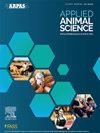Whole blood immune gene expression in Angus bulls with divergent residual feed intake expected progeny differences
IF 1.5
Q3 AGRICULTURE, DAIRY & ANIMAL SCIENCE
引用次数: 0
Abstract
Objective
Our objective was to examine the differ- ences in the whole blood mRNA expression profiles of im- mune-related genes in Angus bulls with either negative or positive residual feed intake expected progeny differences (RFI-EPD).
Materials and Methods
Twenty Angus bulls with the most negative (n = 10; RFI-EPD = −0.29) and most positive (n = 10; RFI-EPD = 0.26) RFI-EPD values were selected from a group of 106 Angus bulls (average BW = 376 ± 36 kg; 370 ± 1.3 d of age) after a 78-d feed ef- ficiency testing period. At the end of this testing period, blood samples were collected for RNA extraction followed by the mRNA expression analysis of 84 genes involved in innate and adaptive immunity using pathway-focused PCR-based arrays. Differentially expressed genes (DEG) were determined using false discovery rate (FDR) ≤0.10.
Results and Discussion
Results from the analysis revealed a total of 5 DEG (FDR ≤0.10) in bulls with divergent RFI-EPD values. We found IL23A to be up- regulated, whereas IL18, TRAF6, TLR2, and MX1 were downregulated in negative RFI-EPD bulls, compared with the positive group. Gene ontology analysis of the DEG indicated the enrichment of different biological pathways linked to innate immune response, NF-κB signaling, cy- tokine and T cell regulation, lipopolysaccharide-mediated signaling pathway, and cellular response to bacteria.
Implications and Applications
These findings re- vealed that negative RFI-EPD bulls exhibit mRNA ex- pression of genes directly related to immune cell function and biological pathways involved in the activation of anti- microbial mechanisms, pathogen recognition mechanisms, and inflammatory response.
不同剩余采食量安格斯公牛全血免疫基因表达预期后代差异
目的研究剩余采食量预期后代差异(RFI-EPD)阴性和阳性的安格斯公牛全血免疫相关基因mRNA表达谱的差异。材料与方法20头阴性安格斯公牛(n = 10;RFI-EPD =−0.29),阳性最多(n = 10;RFI-EPD = 0.26)选取安格斯公牛106头(平均体重= 376±36 kg;在78 d的饲料效率试验期结束后,饲喂期为370±1.3 d。在测试期结束时,采集血液样本进行RNA提取,然后使用基于途径聚焦pcr的阵列分析84个参与先天免疫和适应性免疫的基因的mRNA表达。采用错误发现率(FDR)≤0.10测定差异表达基因(DEG)。结果和讨论分析结果显示,RFI-EPD值不同的公牛共5 DEG (FDR≤0.10)。我们发现,与RFI-EPD阳性组相比,阴性RFI-EPD公牛的IL23A上调,而IL18、TRAF6、TLR2和MX1下调。基因本体论分析表明,DEG富集了与先天免疫应答、NF-κ b信号通路、细胞因子和T细胞调控、脂多糖介导的信号通路以及细胞对细菌应答相关的不同生物通路。这些发现揭示了RFI-EPD阴性公牛表现出与免疫细胞功能和生物途径直接相关的mRNA表达,涉及抗微生物机制、病原体识别机制和炎症反应的激活。
本文章由计算机程序翻译,如有差异,请以英文原文为准。
求助全文
约1分钟内获得全文
求助全文

 求助内容:
求助内容: 应助结果提醒方式:
应助结果提醒方式:


